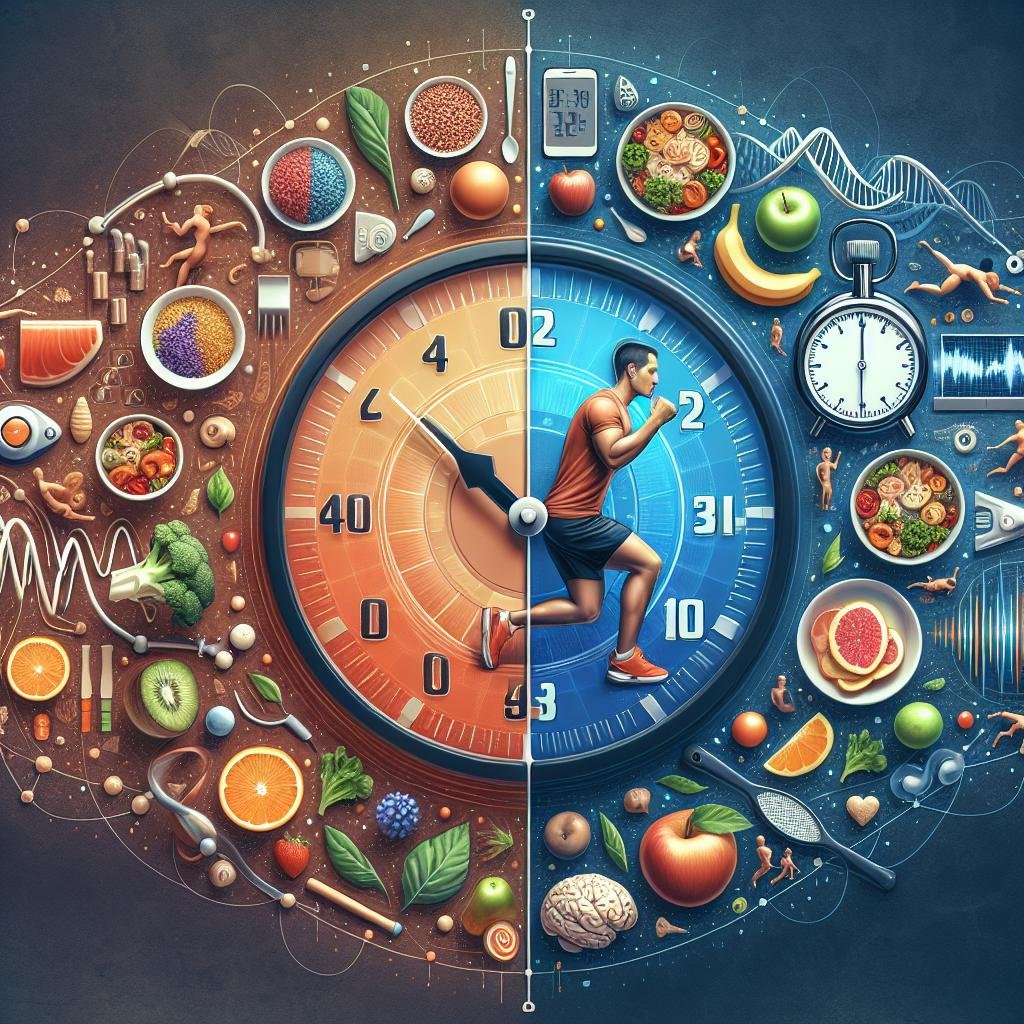In a world that never seems to slow down, the pursuit of effective health and fitness strategies is more relevant than ever. Among the myriad of methods available, two approaches have gained considerable traction: Intermittent Fasting (IF) and High-Intensity Interval Training (HIIT). Each boasts its unique benefits—IF promotes metabolic health and weight management, while HIIT promises quick, efficient workouts that burn calories long after the session ends. But what happens when these two powerhouses collide? In this article, we will explore the art of combining Intermittent Fasting with High-Intensity Interval Training, demystifying the science behind both approaches and offering practical tips on how to harmoniously integrate them into your routine. Whether you’re a seasoned athlete or just beginning your fitness journey, discover how this potent duo can help you achieve optimal results, maximize your time, and elevate your overall well-being.
Maximizing Fat Loss: The Synergy of Intermittent Fasting and HIIT
The combination of intermittent fasting and high-intensity interval training (HIIT) creates a powerful dynamic for anyone seeking to maximize fat loss. By implementing a structured eating window, your body enters a state of ketosis quicker, where it efficiently utilizes fat as a primary energy source. This metabolic shift not only enhances fat oxidation but also allows for improved insulin sensitivity. Moreover, HIIT workouts, which involve short bursts of intense exercise followed by active recovery, can elevate your heart rate and maintain an increased metabolic rate long after the workout has ended. Together, these methods can lead to a significant caloric deficit while preserving lean muscle mass.
To optimize the benefits of both strategies, timing and planning become essential. Consider the following tips to integrate both practices seamlessly into your fitness routine:
- Schedule workouts during fasting periods: Exercising in a fasted state can enhance fat mobilization, making efficient use of the stored fats for energy.
- Prioritize hydration: Staying well-hydrated is crucial when fasting. It can help mitigate hunger and fuel your HIIT sessions effectively.
- Be mindful of post-workout nutrition: Break your fast with nutrient-dense meals that are high in protein to support recovery while replenishing glycogen stores.
This synergistic approach not only enhances physical performance but also facilitates mental clarity and resilience, making it easier to adhere to fitness goals in the long run.

Optimal Timing Strategies: When to Fast and Train for Peak Performance
To maximize the benefits of intermittent fasting (IF) while engaging in high-intensity interval training (HIIT), timing is everything. By aligning your fasting periods with your workout schedule, you can enhance fat burning and muscle preservation. Consider adopting a strategy where you train during the latter part of your fasting window. For example, if you’re following a 16:8 fasting protocol, aim to work out about an hour before your eating window opens. This approach can help deplete glycogen stores, prompting your body to utilize fat as a primary energy source during training.
Additionally, it’s vital to fuel your body appropriately post-workout to support recovery and optimize performance. Incorporating a balanced meal that includes a mix of proteins and healthy fats shortly after your HIIT session can aid muscle repair and replenish energy reserves. Here’s a simple table to illustrate optimal eating times around workouts:
| Time | Activity | Notes |
|---|---|---|
| 7:00 AM | Begin fasting | Start 16-hour fasting window |
| 11:00 AM | Exercise | HIIT workout begins |
| 12:00 PM | End fasting | First meal post-workout |
Sticking to this schedule can help ensure your body remains in an optimal state for both fasting and training, promoting peak performance while facilitating fat loss. Experiment with different timings based on personal preference and listen closely to your body’s response to find the perfect balance that works for you.

Nutrition Essentials: Fueling Your Body Around Workouts
To maximize the benefits of your workouts while incorporating intermittent fasting and high-intensity interval training (HIIT), it’s crucial to pay attention to nutrition timing and macronutrient balance. When fasting, your body adapts to utilizing fat for fuel, making it essential to ensure you consume quality nutrients during your eating window. Focus on incorporating whole foods that are rich in vitamins and minerals, such as:
- Lean Proteins: Chicken, fish, tofu, and legumes help repair muscles post-workout.
- Complex Carbohydrates: Quinoa, brown rice, and sweet potatoes provide lasting energy for intense sessions.
- Healthy Fats: Avocados, nuts, and olive oil support recovery and hormone balance.
It’s beneficial to establish a distinct eating regimen to optimize performance. Consider a table format to plan your meals effectively around both fasting and workout schedules:
| Time | Activity | Nutrition Focus |
|---|---|---|
| 7:00 AM | Workout | Pre-workout hydration (water or electrolyte drink) |
| 8:00 AM | Post-workout | High-protein meal (e.g., omelet with veggies and whole-grain toast) |
| 12:00 PM | Lunch | Balanced meal with carbs, protein, and healthy fats (salad with grilled chicken and nuts) |
Balancing your meals and snacks will not only keep your energy levels steady throughout the day but will also support muscle recovery and overall health. Be mindful to listen to your body—adjust your intake based on how you feel and your performance levels, ensuring you’re adequately fueling your workouts and aiding recovery effectively.

Mindfulness and Recovery: Balancing Intensity with Rest for Sustainable Progress
Emphasizing the equilibrium between effort and recovery is crucial for long-term success in any regimen, especially when engaging in Intermittent Fasting and High-Intensity Interval Training (HIIT). Practicing mindfulness can enhance this balance by fostering a deeper awareness of your body’s signals. When you’re aware of how your body feels during and after intense training sessions, you can make more informed decisions about when to push hard and when to allow yourself to rest. Integrating mindfulness techniques, such as meditation or focused breathing, can help develop this awareness, making it easier to tune in to your energy levels and recovery needs.
Establishing a structured approach that incorporates both intensity and rest can lead to significant improvements in performance and well-being. Consider the following tips to strike the right balance:
- Schedule Recovery Days: Build rest days into your routine to allow your body to recover fully.
- Prioritize Quality Sleep: Adequate sleep supports recovery and enhances workout performance.
- Engage in Gentle Movement: Activities like yoga or walking can aid recovery without compromising your fasting and training efforts.
- Practice Mindfulness: Regular mindfulness practices can improve focus, reduce stress, and enhance your overall experience.
Closing Remarks
In the journey towards optimal health and fitness, the synergy between intermittent fasting and high-intensity interval training can serve as a powerful catalyst for transformation. As you integrate these two dynamic approaches, remember that the key lies in listening to your body’s signals and adjusting your strategies to align with your personal goals and lifestyle. Whether you’re seeking weight loss, enhanced endurance, or simply a rejuvenated sense of well-being, the careful balance of timing your meals and structuring your workouts can unlock new levels of performance and satisfaction.
As you embark on this empowering path, stay curious and flexible; the landscape of health is ever-evolving, and what works for one may not suit another. Ultimately, the most sustainable results come from a blend of science, intuition, and adaptability. So, take your knowledge, experiment with your routine, and enjoy the journey of discovery as you harness the potential of intermittent fasting and high-intensity interval training together. Here’s to your health—may it flourish in every dimension!

